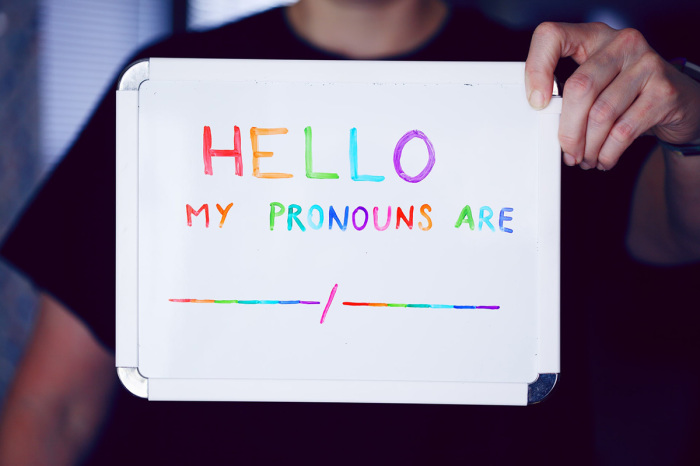Trump’s cuts to NPR, PBS and foreign aid clear Congress – NBC News

Report on U.S. Legislative Spending Cuts and Their Implications for Sustainable Development Goals
1.0 Executive Summary
The United States House of Representatives has passed a bill authorizing $9 billion in spending cuts, targeting foreign aid and domestic public media. This legislative action carries significant implications for the advancement of several United. Nations Sustainable Development Goals (SDGs), particularly those related to global health, poverty reduction, education, inequality, and international partnerships.
2.0 Legislative Overview
A bill to rescind $9 billion in previously approved funding was passed by the House of Representatives with a vote of 216-213. The measure, which previously passed the Senate, now proceeds to the President for enactment. The cuts were advanced through a “rescissions” process, allowing for passage with a simple majority.
2.1 Allocation of Cuts
- Foreign Aid: $8 billion rescinded from programs including the U.S. Agency for International Development (USAID), global health initiatives, and refugee assistance.
- Public Media: $1.1 billion rescinded from the Corporation for Public Broadcasting, which funds National Public Radio (NPR) and the Public Broadcasting Service (PBS).
2.2 Notable Exclusions
An initial proposal to cut $400 million from the President’s Emergency Plan for AIDS Relief (PEPFAR) was removed from the final bill, preserving funding for the program.
3.0 Impact on Global Sustainable Development Goals
The reduction in foreign aid directly challenges the progress of multiple SDGs by curtailing resources for international development and humanitarian efforts.
3.1 SDG 1 (No Poverty) and SDG 10 (Reduced Inequalities)
The $8 billion cut to foreign aid, including funds for USAID, is projected to negatively affect programs aimed at poverty eradication and reducing economic inequalities between nations. These initiatives are fundamental to achieving the targets of SDG 1 and SDG 10.
3.2 SDG 3 (Good Health and Well-being)
While funding for PEPFAR was preserved, the broader cuts to global health and refugee assistance programs threaten progress on SDG 3. These programs are critical for addressing a range of health crises and supporting vulnerable populations. The preservation of PEPFAR funding, however, signals continued commitment to the specific SDG 3 target of ending the epidemics of AIDS and other communicable diseases.
3.3 SDG 16 (Peace, Justice and Strong Institutions) and SDG 17 (Partnerships for the Goals)
Reductions in foreign aid undermine SDG 17 by weakening international partnerships essential for sustainable development. Furthermore, cuts to programs that support global stability and provide refugee assistance could impede progress toward SDG 16, which seeks to promote peaceful and inclusive societies.
4.0 Impact on Domestic Sustainable Development Goals
The rescission of funding for the Corporation for Public Broadcasting has direct consequences for SDGs related to education and inequality within the United States.
4.1 SDG 4 (Quality Education)
The $1.1 billion cut to public broadcasting threatens a key source of free and accessible educational content for all Americans. The Corporation for Public Broadcasting has stated that the cuts will have “profound, lasting, negative consequences,” potentially limiting access to informal educational resources that support lifelong learning, a core component of SDG 4.
4.2 SDG 10 (Reduced Inequalities) and SDG 16 (Peace, Justice and Strong Institutions)
Opponents of the cuts argue they will disproportionately harm rural and tribal communities, exacerbating domestic inequalities in access to information, which is contrary to the aims of SDG 10.
- Information Access: Local public media stations serve as a primary source of news and information in underserved areas. Their potential closure would reduce access to trustworthy information, which is vital for the strong and transparent institutions promoted by SDG 16.
- Public Safety: Public radio is a critical component of the emergency alert system in many rural areas. Reduced funding could compromise this public safety infrastructure.
Which SDGs are addressed or connected to the issues highlighted in the article?
-
SDG 3: Good Health and Well-being
The article discusses cuts to foreign aid, which includes programs for “global health.” It also specifically mentions the debate around funding for PEPFAR, a program to combat HIV/AIDS, directly linking the bill to global health outcomes.
-
SDG 10: Reduced Inequalities
The bill includes cuts to “refugee assistance” programs. These programs are essential for supporting vulnerable and displaced populations, and reducing their funding directly impacts efforts to reduce inequalities for these groups. The article also highlights that the cuts to public media will disproportionately affect “rural and tribal communities,” exacerbating inequalities in access to information and services.
-
SDG 11: Sustainable Cities and Communities
The article points out that public radio serves as a “lifeline” for rural communities by providing “life-saving emergency broadcasting and weather alerts.” Cutting funding threatens the resilience and safety of these communities, which is a key aspect of SDG 11.
-
SDG 16: Peace, Justice and Strong Institutions
This goal is central to the article’s focus on public media. The cuts to the Corporation for Public Broadcasting are described as a threat to public access to information. The article quotes statements that the cuts will result in “less trustworthy information” and the shutdown of “local public radio and television stations,” which are vital civic institutions.
-
SDG 17: Partnerships for the Goals
The article details a significant cut of “$8 billion more from foreign aid,” including funding for the U.S. Agency for International Development (USAID). This directly impacts international cooperation and the financial resources (Official Development Assistance) provided to support sustainable development in other countries.
What specific targets under those SDGs can be identified based on the article’s content?
-
Target 3.3: End the epidemics of AIDS, tuberculosis, malaria and other communicable diseases
This target is relevant through the discussion of PEPFAR, the “popular Bush-era foreign aid program to combat HIV/AIDS.” Although the proposed cuts to PEPFAR were ultimately removed, the initial inclusion and the broader cuts to “global health” funding directly relate to the resources available to fight epidemics like HIV/AIDS.
-
Target 10.7: Facilitate orderly, safe, regular and responsible migration and mobility of people
The article states that the $8 billion in foreign aid cuts includes funding for “refugee assistance.” This directly relates to the target of managing migration and mobility, as assistance programs are crucial for the safety and well-being of refugees.
-
Target 11.5: Significantly reduce the number of deaths and people affected by disasters
This target is implicated by the potential impact of public media cuts on rural areas. The article notes that “Public radio is also a lifeline… providing life-saving emergency broadcasting and weather alerts.” The loss of this service would weaken early warning systems and increase the vulnerability of these communities to disasters.
-
Target 16.10: Ensure public access to information and protect fundamental freedoms
This is one of the most clearly identified targets. The article extensively covers the consequences of cutting funding for NPR and PBS, stating it would lead to “many local public radio and television stations shutting shut down” and that “millions of Americans will have less trustworthy information about their communities, states, country, and world.”
-
Target 17.2: Developed countries to implement fully their official development assistance commitments
The article explicitly mentions a cut of “$8 billion more from foreign aid.” This action is a direct move away from fulfilling development assistance commitments, which is the focus of this target.
Are there any indicators mentioned or implied in the article that can be used to measure progress towards the identified targets?
-
Financial flows for development assistance
The article provides a specific monetary figure: a “$9 billion” cut in total, with “$8 billion” from foreign aid. This amount serves as a direct indicator of the reduction in Official Development Assistance (ODA), relevant to Target 17.2.
-
Funding for specific global health programs
The discussion around PEPFAR implies that the level of funding for programs combating specific diseases like HIV/AIDS is a key indicator. The initial proposal to cut $400 million from PEPFAR is a quantifiable measure related to Target 3.3.
-
Availability of public information services
An implied indicator for Target 16.10 is the number of public media stations in operation. The article warns that the cuts would lead to “many local public radio and television stations shutting shut down,” which is a measurable outcome reflecting a decrease in public access to information.
-
Reach of emergency alert systems
For Target 11.5, an indicator is the population’s access to emergency alerts. The article states that “Nearly 3-in-4 Americans say they rely on their public radio stations for alerts.” A reduction in stations, particularly in rural areas, would directly decrease the reach of these life-saving systems, a measurable impact.
-
Funding for refugee support
The article identifies “refugee assistance” as an area facing cuts. The amount of funding allocated to these programs is a direct indicator of the support provided to vulnerable populations, relevant to Target 10.7.
Table of SDGs, Targets, and Indicators
| SDGs | Targets | Indicators |
|---|---|---|
| SDG 3: Good Health and Well-being | 3.3: End the epidemics of AIDS… and other communicable diseases. | The amount of funding allocated to global health programs, such as the proposed (but removed) $400 million cut to PEPFAR to combat HIV/AIDS. |
| SDG 10: Reduced Inequalities | 10.7: Facilitate orderly, safe, regular and responsible migration and mobility of people. | The level of funding for “refugee assistance” programs, which the article states is being cut. |
| SDG 11: Sustainable Cities and Communities | 11.5: Significantly reduce the number of deaths and people affected by disasters. | The number of communities, especially “rural communities,” with access to “life-saving emergency broadcasting and weather alerts” via public radio. |
| SDG 16: Peace, Justice and Strong Institutions | 16.10: Ensure public access to information and protect fundamental freedoms. | The number of “local public radio and television stations” at risk of shutting down, reducing access to “trustworthy information.” |
| SDG 17: Partnerships for the Goals | 17.2: Developed countries to implement fully their official development assistance commitments. | The total amount of Official Development Assistance (ODA) cut, specified in the article as “$8 billion more from foreign aid.” |
Source: nbcnews.com

What is Your Reaction?
 Like
0
Like
0
 Dislike
0
Dislike
0
 Love
0
Love
0
 Funny
0
Funny
0
 Angry
0
Angry
0
 Sad
0
Sad
0
 Wow
0
Wow
0








































































